All publications
Aspects of Death and the Afterlife in Greek Literature, ed. George Gazis & Anthony Hooper (2021)
-Aspects-of-Death-and-the-Afterlife-in-Greek-Literature-180x270.png) Aspects of Death and the Afterlife in Greek Literature, edited by George Alexander Gazis & Anthony Hooper. Liverpool: Liverpool University Press, 2021. eBook ISBN: 9781789627350 • Hardback ISBN: 978-1-789-62149-5
Aspects of Death and the Afterlife in Greek Literature, edited by George Alexander Gazis & Anthony Hooper. Liverpool: Liverpool University Press, 2021. eBook ISBN: 9781789627350 • Hardback ISBN: 978-1-789-62149-5
Links: Liverpool University Press
About the Book:
The concept of the afterlife has always been prominent in both Greek literature and modern scholarship alike. The fate of man after his/her allotted time has come to an end has a central position in poetry, philosophy and religion, often leading to questions and answers as to how one can best live one’s life, and how can one deal with the burden of mortality that is inherent in every human being. The Greeks devoted a considerable amount of their literary production in an attempt to answer these questions through a variety of different media, whereas similar concerns appear to have been at the core of the ancient world in general. This volume represents the first to examine the influences, intersections, and developments of understandings of death and the afterlife between poetic, religious, and philosophical traditions in ancient Greece in one resource. Greek thinking on death and the afterlife was neither uniform, simple, nor static, and by offering an examination of these matters in a properly interdisciplinary context this collection of papers aims to demonstrate the full richness, complexity, and flexibility of these ideas in the ancient Greek world, and illuminate how freely writers from various genres drew inspiration from each other’s thinking concerning eschatological matters.
Contributors:
Alberto Benarbé; Rick Benitez; Nicolo Benzi; Chiara Blanco; Radcliffe Edmonds; George Alexander Gazis; Anthony Hooper; Vaios Liapis; Alex Long; Ioannis Ziogas.
About the Editors:
George Alexander Gazis is an Assistant Professor in Greek Literature at the Department of Classics and Ancient History, Durham University. He is the author of Homer and the poetics of Hades (OUP 2018). Anthony Hooper is Lecturer at the School of Liberal Arts, University of Wollongong, Australia. His research focuses particularly on intersections between Greek philosophy, poetry, and religion.
'Bereavement, Sacred-Secrecy and Dreams', Douglas Davies (2021)
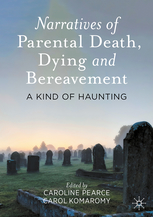 Douglas Davies, 'Bereavement, Sacred-Secrecy and Dreams', in Narratives of Parental Death, Dying and Bereavement: A Kind of Haunting, edited by Caroline Pearce & Carol Komaromy. London, Palgrave Macmillan, 2021. Pp. 55-73. eBook ISBN: 978-3-030-70894-8 • Softcover ISBN: 978-3-030-70893-1 • DOI: 10.1007/978-3-030-70894-8
Douglas Davies, 'Bereavement, Sacred-Secrecy and Dreams', in Narratives of Parental Death, Dying and Bereavement: A Kind of Haunting, edited by Caroline Pearce & Carol Komaromy. London, Palgrave Macmillan, 2021. Pp. 55-73. eBook ISBN: 978-3-030-70894-8 • Softcover ISBN: 978-3-030-70893-1 • DOI: 10.1007/978-3-030-70894-8
Links: Palgrave Macmillan
About the Book:
This collection shows what happens when facing the inevitable and sometimes expected death of a parent, and how such an ordinary part of life as parental death might connect with the children left behind. In many ways, individual deaths are extraordinary and leave a unique legacy – a kind of haunting.
The authors' accounts seek to make sense of death through witnessing its enactment and recording its detail. All the authors are experienced researchers in the field of death studies, and their collective expertise encompasses ethnography, psychology, sociology and anthropology. The individual descriptions of death and grief capture the everyday practicalities of managing death and dying, including, for example, the difficulties of caring responsibilities and the realities of dealing with strained family relationships. These accounts show the raw detail of death; they are deeply personal observations framed within critical theories.
As established scholars and practitioners that have researched and worked in end-of-life and bereavement care, the authors in this anthology offer a unique perspective on how identity is shaped by a close bereavement. The book employs a strong editorial narrative that blends memoir with theoretical engagement, and will be of interest to death studies scholars, as well as practitioners involved in end-of-life care and bereavement care and anyone who has experienced the death of a parent.
About the Editors:
Caroline Pearce is a Visiting Researcher at the Palliative and End of Life Care Group, University of Cambridge, UK.
Carol Komaromy is a medical sociologist who has worked extensively in both NHS clinical practice and academia. She served as co-editor of the journal Mortality and was a founding member of the Association of Death and Society. Carol has retired from full-time work but is an honorary associate of The Open University, UK.
Designs on Death, Hilary Grainger (2020)
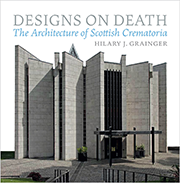 Designs on Death: The Architecture of Scottish Crematoria, by Hilary J. Grainger. Edinburgh: John Donald (Birlinn Ltd.). 2020. ISBN: 9781910900307
Designs on Death: The Architecture of Scottish Crematoria, by Hilary J. Grainger. Edinburgh: John Donald (Birlinn Ltd.). 2020. ISBN: 9781910900307
Links: Birlinn
About the Book:
Despite seven out of ten people in Scotland choosing cremation, in many ways crematoria are ‘invisible’ buildings, visited only by necessity, and they have not received the attention they deserve. Crematoria present a real challenge for architects. They are paradoxical buildings: religious and secular, functional and symbolic, required to satisfy the practical and emotional needs of all faiths and none.
This book provides architectural ‘biographies’ of Scotland’s thirty-one crematoria, explaining their increasing relevance in contemporary Scottish society and pointing to Scotland’s distinctive contribution to the progress of cremation and the architecture of crematoria. Many leading architects and craftsmen, including Sir Robert Lorimer and Sir Basil Spence, produced designs of great architectural merit, and Scottish local authorities led the way in designing some of the most progressive crematoria in the UK. These singular often contested buildings, many in magnificent natural landscape settings, reveal a great deal about the complex, changing and distinctive attitudes to death and funeral rituals in Scotland.
About the Author:
Hilary Grainger is a Dean and Professor of Architectural History at the University of the Arts, London, Chair of the Victorian Society, and an Honorary Professor of the CDALS.
Visitors at the End of Life, Alan Kellehear (2020)
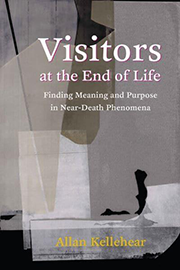 Visitors at the End of Life: Finding Meaning and Purpose in Near-Death Phenomena, by Allan Kellehear. New York, NY: Columbia University Press. 2020. ISBN: 9780231182157
Visitors at the End of Life: Finding Meaning and Purpose in Near-Death Phenomena, by Allan Kellehear. New York, NY: Columbia University Press. 2020. ISBN: 9780231182157
Links: Columbia University Press • Durham University Libraries
About the Book:
About 30 per cent of hospice patients report a “visitation” by someone who is not there, a phenomenon known in end-of-life care as a deathbed vision. These visions can be of dead friends or family members and occur on average three days before death. Strikingly, individuals from wildly diverse geographic regions and religions - from New York to Japan to Moldova to Papua New Guinea - report similar visions. Appearances of our dead during serious illness, crises, or bereavement are as old as the historical record. But in recent years, we have tended to explain them in either the fantastical terms of the supernatural or the reductive terms of neuroscience.
This book is about how, when, and why our dead visit us. Allan Kellehear - a medical sociologist and expert on death, dying, and palliative care - has gathered data and conducted studies on these experiences across cultures. He also draws on the long-neglected work of early anthropologists who developed cultural explanations about why the dead visit. Deathbed visions conform to the rituals that underpin basic social relations and expectations - customs of greeting, support, exchange, gift-giving, and vigils - because the dead must communicate with us in a social language that we recognise. Kellehear emphasises the personal consequences for those who encounter these visions, revealing their significance for how the dying person makes meaning of their experiences. Providing a vital understanding of a widespread yet mysterious phenomenon, Visitors at the End of Life offers insights for palliative care professionals, researchers, and the bereaved.
About the Author:
Allan Kellehear is the 50th Anniversary Professor of End of Life Care at the University of Bradford, and an Honorary Professor of the CDALS. His books include A Social History of Dying (2007) and The Inner Life of the Dying Person (Columbia, 2014).
Death, Religion and Law, Peter Hutton, Ravi Mahajan, & Allan Kellehear (2019)
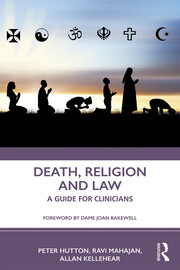 Death, Religion and Law: A Guide For Clinicians, by Peter Hutton, Ravi Mahajan & Allan Kellehear. London: Routledge. 2019. ISBN: 9781138592896
Death, Religion and Law: A Guide For Clinicians, by Peter Hutton, Ravi Mahajan & Allan Kellehear. London: Routledge. 2019. ISBN: 9781138592896
Links: Routledge
About the Book:
This practical guide summarises the principles of working with dying patients and their families as influenced by the commoner world religions and secular philosophies. It also outlines the main legal requirements to be followed by those who care for the dying following the death of the patient.
The first part of the book provides a reflective introduction to the general influences of world religions on matters to do with dying, death and grief. It considers the sometimes conflicting relationships between ethics, religion, culture and personal philosophies and how these differences impact on individual cases of dying, death and loss. The second part describes the general customs and beliefs of the major religions that are encountered in hospitals, hospices, care homes and home care settings. It also includes discussion of non-religious spirituality, humanism, agnosticism and atheism. The final part outlines key socio-legal aspects of death across the UK.
Death, Religion and Law provides key knowledge, discussion and reflection for dealing with the diversity of the everyday care of dying and death in different religious, secular and cultural contexts. It is an important reference for practitioners working with dying patients, their families and the bereaved.
About the Authors:
Peter Hutton was Professor of Anaesthesia at Birmingham University, an Honorary Consultant at University Hospital Birmingham and a Medical Examiner. He is now a non-Executive Director of the Royal Brompton and Harefield Hospitals.
Ravi Mahajan is Professor of Anaesthesia and Intensive Care at Nottingham University, UK.
Allan Kellehear is 50th Anniversary Professor (End of Life Care), Faculty of Health Studies, University of Bradford, UK, and an Honorary Professor of the CDALS.
Cremation in Modern Scotland, Peter C. Jupp et al. (2017)
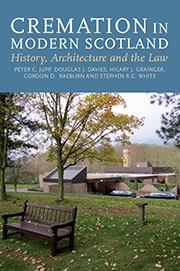 Cremation in Modern Scotland: History, Architecture and the Law, by Peter C. Jupp, Douglas J. Davies, Hilary J. Grainger, Gordon D. Raeburn & Stephen R. G. White. Edinburgh: John Donald (Birlinn Ltd.). Published in Association with the Cremation Society of Great Britain. 2017. ISBN: 9781906566791
Cremation in Modern Scotland: History, Architecture and the Law, by Peter C. Jupp, Douglas J. Davies, Hilary J. Grainger, Gordon D. Raeburn & Stephen R. G. White. Edinburgh: John Donald (Birlinn Ltd.). Published in Association with the Cremation Society of Great Britain. 2017. ISBN: 9781906566791
Links: Birlinn • Durham University Libraries
This 327 page volume is the extended outcome of an original Leverhulme Funded Project Cremation in Scotland based at Durham’s Centre for Death and Life Studies. As a genuinely interdisciplinary study it is notable that no single chapter author is cited as such, since colleagues worked together to produce the final product. Its subtitled topics are complemented by work on the theological and ecclesiastical history lying behind Scotland’s Reformation and ensuing funerary practices.
Changes in funeral practice provide a lens through which to inspect changes in wider social identity, values and religious beliefs. This book reveals how, in Scotland, as in other societies, death ways and funeral arrangements are closely related to other aspects of life, from religious beliefs to political convictions, from family relationships to class structure, from poverty to prosperity.
The book adopts an interdisciplinary approach, analysing particularly the part played by Scottish law and architecture. Until recently, Scotland’s 28 crematoria have been the ‘invisible buildings’ of the twentieth century, absent from architectural histories. The book analyses the challenge this new building type provided for architects: a building with no architectural precedent, at once secular and religious, functional and symbolic. From archives previously unstudied and from primary and secondary legal materials, it traces the development of Scottish law on burial and cremation. It will be an invaluable aid to those wishing to know the historical background to the Burial and Cremation Bill currently going through the Scottish Parliament.
In just forty years the people of Scotland made a striking change to their age-old custom of burying their dead. In 1939, 97 per cent of Scots funerals ended with burial; by 1977 over 50 per cent ended with cremation. This book tells the story of this change. It interprets the crises in burial practice in nineteenth-century urban Scotland and constructs the very first account of how Scottish cremationists pioneered a radical alternative to burial.
Death, Ritual and Belief, Douglas Davies (3rd edn. 2017)
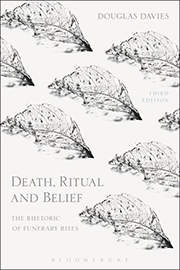 Death, Ritual and Belief: The Rhetoric of Funerary Rites (3rd edn.), by Douglas Davies. London; Oxford; New York, NY: Bloomsbury Academic. 2017. ISBN: 9781474250979
Death, Ritual and Belief: The Rhetoric of Funerary Rites (3rd edn.), by Douglas Davies. London; Oxford; New York, NY: Bloomsbury Academic. 2017. ISBN: 9781474250979
Links: Bloomsbury • Durham University Libraries
Describing a great variety of funeral ritual from major world religions and from local traditions, this book shows how cultures not only cope with corpses but also create an added value for living through the encouragement of afterlife beliefs. The explosion of interest in death in recent years reflects the key theme of this book - the rhetoric of death - the way cultures use the most potent weapon of words to bring new power to life. This new edition is one third longer than the original with new material on the death of Jesus, the most theorised death ever which offers a useful case study for students. There is also empirical material from contemporary/recent events such as the death of Diana and an expanded section on theories of grief which will make the book more attractive to death counsellors.
About the Book:
Death, Ritual and Belief, now in its third edition, explores many important issues related to death and dying, from a religious studies perspective, including anthropology and sociology. Using the motif of 'words against death' it depicts human responses to grief by surveying the many ways in which people have not let death have the last word, not simply in terms of funeral rites but also in memorials, graves, and in ideas of ancestors, souls, gods, reincarnation and resurrection, whether in the great religious traditions of the world or in more local customs. He also examines bereavement and grief, experiences of the presence of dead, near-death experiences, pet-death and the symbolic death played out in religious rites.
Updated chapters have taken into account new research and include additional topics in this new edition, notably assisted dying, terrorism, green burial, material culture, death online, and the emergence of Death Studies as a distinctive field. Case studies range from Anders Breivik in Norway, to the Princess of Wales, and to the Rapture in the USA. A new perspective is also brought to his account of grief theories.
Providing an introduction to key authors and authorities on death beliefs, bereavement, grief and ritual-symbolism, Death, Ritual and Belief is an authoritative guide to the perspectives of major religious and secular worldviews.
Mors Britannica: Lifestyle and Death-Style in Britain Today, Douglas Davies (2015)
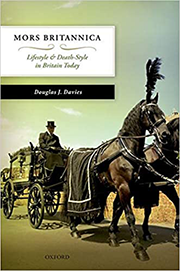 Mors Britannica: Lifestyle and Death-Style in Britain Today, by Douglas J. Davies. Oxford: Oxford University Press. ISBN: 9780199644971 • DOI: 10.1093/acprof:oso/9780199644971.001.0001
Mors Britannica: Lifestyle and Death-Style in Britain Today, by Douglas J. Davies. Oxford: Oxford University Press. ISBN: 9780199644971 • DOI: 10.1093/acprof:oso/9780199644971.001.0001
Links: Oxford University Press • Oxford Scholarship Online • Durham University Libraries: e-book, physical book
Analyses British attitudes towards and practices surrounding death.
Explains that deaths and often the anniversary of the death of establishment and celebrity figures mark the ongoing cultural life of Britain.
Draws largely from an anthropological-sociological perspective but also looks at history, literature, philosophy, psychology, and theology.
Addresses the style issue in a society where cultural changes involve distinctions between traditional religion, secularisation, and emergent forms of spirituality.
Develops a theoretical approach to life-meaning in relation to death.
Abstract:
This anthropology-sociology of British religion aligns lifestyle and what it calls death-style; traditional and innovative forms of funeral and memorial serve as windows upon British life. Traditional cemetery and innovative woodland/green burials, cremation, ashes, and diversity of ritual leaders offer sources for analysing social change, religion, spirituality, and secular world views. Mortality and vitality as key biological dynamics transform and integrate into social forces evident in the British Establishment and the country’s National Health Service and Welfare State. Creative individuals like those who drove the development of woodland burial, the National Memorial Arboretum, and the Memorial for those dying in the Falklands War are described here, as are major and minor memorials for military, civilian, and family deaths and disasters. Celebrity deaths ensure that media power is also highlighted, and the pervasive influence of digital social media upon individuals is considered. Social theory and contemporary research on afterlife beliefs combine with historical, literary, mythical, artistic, musical, and theological studies to discuss identity and mortality’s meaning. Issues of cultural wisdom, wellbeing, and mindfulness play their part, alongside theories of reciprocity, dual sovereignty of authority, elective affinity, moral somatics, emotions, the uncanny, and paradigmatic scenes of human embodiment. Classical and often ignored scholars, and national ceremonial and intimate personal grief frame issues of good and bad deaths as ‘establishment’, and innovative sources debate issues of suicide and assisted dying at a time when traditional religion vies with spirituality, ethical committees, and invented ritual to furnish today’s bereaved people with a lifestyle-matching death-style.
Keywords: afterlife, assisted dying, burial, death-style, funeral, human embodiment, lifestyle, mortality, suicide, vitality.
Natural Burial, Douglas Davies & Hannah Rumble (2012)
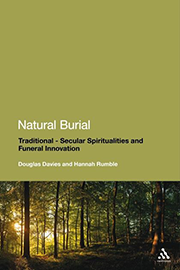 Natural Burial: Traditional - Secular Spiritualities and Funeral Innovation, by Douglas Davies & Hannah Rumble. London: Continuum. 2012. ISBN: 9781441122964
Natural Burial: Traditional - Secular Spiritualities and Funeral Innovation, by Douglas Davies & Hannah Rumble. London: Continuum. 2012. ISBN: 9781441122964
Links: Bloomsbury • Durham University Libraries
About the Book:
From the 1990s the British developed an interest in natural burial, also known as woodland, green, or ecological burial. Natural burial constitutes part of a long, historical legacy for British funeral innovation; from Victorian cemetery monuments and garden cemeteries through the birth and rise of cremation to the many things done with cremated remains. The book sets natural burial in the context of such creative dealing with death, grief, mourning, and the celebration of life. Themes from sociology and anthropology combine with psychological issues and theological ideas to show how human emotions take shape and help people consider their own death whilst also dealing with the death of those they love.
The authors explore the variety of motivations for people to engage with natural burial and its popular appeal, using interviews with people having a relationship with one natural burial site created by the Church of England but open to all. They illustrate people's understandings of life and death in the sacred, secular and mixed worlds of modern Britain.
Emotion, Identity and Death, ed. Douglas J. Davies & Chang-Won Park (2012)
Emotion, Identity and Death: Mortality Across Disciplines, edited by Douglas Davies & Chang-Won Park. Farnham; Burlington, VT: Ashgate. 2012. ISBN:
Links: Routledge • Durham University Libraries: e-book, physical book
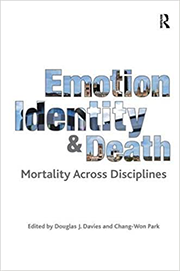 About the Book:
About the Book:
Death affects all aspects of life, it touches our emotions and influences our identity. Presenting a kaleidoscope of informative views of death, dying and human response, this book reveals how different disciplines contribute to understanding the theme of death. Drawing together new and established scholars, this is the first book among the studies of emotion that focuses on issues surrounding death and the first among death studies that focuses on the issue of emotion.
Themes explored include: themes of grief in the ties that bind the living and the dead, funerals, public memorials and the art of consolation, obituaries and issues of war and death-row, use of the internet in dying and grieving, what people do with cremated remains, new rituals of spiritual care in medical contexts, themes bounded and expressed through music, and more.
About the Editors:
Douglas Davies, Professor in the Study of Religion and Director of The Centre for Death and Life Studies, Durham University. Chang-Won Park, Honorary Research Associate, The Centre for Death and Life Studies, Durham University and Senior Research Fellow, Institute for the Study of Religion, Sogang University, South Korea.
'Ethics of Cremation and Religion', Douglas Davies (2012)
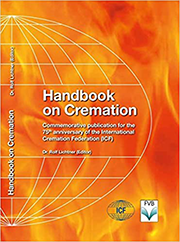 Douglas Davies, 'Ethics of Cremation and Religion', in Handbook on Cremation, edited by Rolf Lichtner. Dusseldorf: Fachverlag des deutschen Bestattungsgewerbes, 2012. Pp. 55-73. ISBN: 978-3-936057-35-5.
Douglas Davies, 'Ethics of Cremation and Religion', in Handbook on Cremation, edited by Rolf Lichtner. Dusseldorf: Fachverlag des deutschen Bestattungsgewerbes, 2012. Pp. 55-73. ISBN: 978-3-936057-35-5.
Links: ISBN.de
The Handbook on Cremation describes important aspects of cremation. The history of cremation is described by Todd van Beck, complimented by an article from Roger Arber about the development of cremation and statistical global cremation data and a description of the International Cremation Federation and its goals by the Secretary-General of the ICF, Henry J. Keizer.
The ethical aspects of cremation are predominately focused on in the contributions of the following authors: Professor Davies writes about the ethical foundations of cremations in the religions; Jan Gabriels, MD, is the author of the legal and ethical aspects of the use of metals after cremation; Shoji Eguchi’s contribution gives a detailed description of cremation in Japan, and the planning and operational aspects for crematory are summarised by Peter McLean. Several detailed contributions cover the technological aspects of a crematorium. Designs for furnace constructions (Dr Gebhard Schetter, Dieter Zahn), designs for filter technology (Dr Ole Petzoldt), emissions and emission control (Benjamin Wiechmann/Markus Gleis), developments in filter techniques for crematoria and saving energy and sustainable development (Andrew Mallalieu), measuring and control technology for emission control (Bruno Vater) and sanitary requirements at crematories (Dr Gabriele Righi/Dr Edda Guareschi) provide a broad and extensive overview of today’s technology.
The fourth part of the book is entitled “Standards and Qualifications”, which includes articles about the standardisation for crematories by Peter Plegnière, quality assurance for crematories by Svend-Jörk Sobolewski, professional formation and development concepts for crematory employees by Duncan McCallum, as well as educational aspects - now and in the future - by Dr Rolf Lichtner.
Cultural Blending in Korean Death Rites, Chang-Won Park (2010)
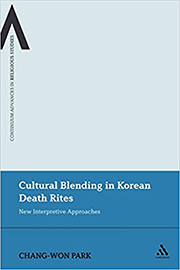 Cultural Blending in Korean Death Rites: New Interpretive Approaches, by Chan-Won Park. London: Continuum. 2010. ISBN: 9781441122964
Cultural Blending in Korean Death Rites: New Interpretive Approaches, by Chan-Won Park. London: Continuum. 2010. ISBN: 9781441122964
Links: Bloomsbury • Durham University Libraries
This is a developed form of Dr Chang-Won Park's doctoral study completed at Durham. It adopts a clear anthropological perspective as it takes reciprocity or gift-theory approach to rites conducted by elderly people before their death, especially in the production of hand-written copies of the Bible in Korea, to rites associated with death, and with rites that follow later, all as part of a 'total social process'. It reveals the interaction of enduring Confucian traditions with those of Christianity in Korean religious history.
Cultural Blending in Korean Death Rites examines the cultural encounter of Confucianism and Christianity with particular reference to death rites in Korea. As its overarching interpretive framework, this book employs the idea of the 'total social phenomenon', a concept first introduced by the French anthropologist Marcel Mauss (1872-1950).
From the perspective of the total social phenomenon, this book utilizes a combination of theological, historical, sociological and anthropological approaches, and explores Korean death rites by classifying them into three categories: ritual before death (Bible copying), ritual at death (funerary rites),and ritual after death (ancestral ritual). It focuses on Christian practices as they epitomize the complex interplay of Confucianism and Christianity. By drawing on a total social phenomenon approach to the empirical case of Korean death rites, Chang-Won Park contributes to the advancement of theory and method in religious studies.
Encyclopedia of Cremation, ed. Douglas J. Davies & Lewis H. Mates (2005)
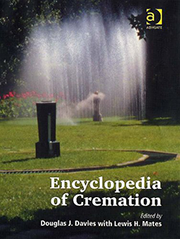 Encyclopedia of Cremation, edited by Douglas J. Davies with Lewis H. Mates. Aldershot; Burlington, VT: Ashgate Publishing. 2005. ISBN: 978-0-7546-3773-8
Encyclopedia of Cremation, edited by Douglas J. Davies with Lewis H. Mates. Aldershot; Burlington, VT: Ashgate Publishing. 2005. ISBN: 978-0-7546-3773-8
Links: Routledge • Durham University Libraries: e-book 1, e-book 2, physical book
About the Book:
The Encyclopedia of Cremation is the first major reference resource focused on cremation. Spanning many world cultures it documents regional histories, ideological movements and leading individuals that fostered cremation whilst also presenting cremation as a universal practice. Tracing ancient and classical cremation sites, historical and contemporary cremation processes and procedures of both scientific and legal kind, the encyclopedia also includes sections on specific cremation rituals, architecture, art and text. Features in the volume include a general introduction and editorial introductions to sub-sections by Douglas Davies', an international specialist in death studies; appendices of world cremation statistics and a chronology of cremation; cross-referencing pathways through the entries via the index; individual entry bibliographies; and illustrations. This major international reference work is also an essential sourcebook for students on the growing number of death-studies courses and wider studies in religion, anthropology or sociology.
About the Editors:
Douglas J. Davies is Professor in the Study of Religion at Durham University, UK. Lewis Mates formerly Golders Green Research Assistant at Durham University, UK.
A Brief History of Death, Douglas Davies (2005)
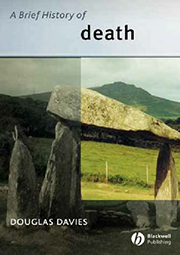 A Brief History of Death, by Douglas Davies. Malden, MA; Oxford: Blackwell Publishing. 2005. ISBN: 978-1-405-10183-7
A Brief History of Death, by Douglas Davies. Malden, MA; Oxford: Blackwell Publishing. 2005. ISBN: 978-1-405-10183-7
Links: Wiley • Durham University Libraries: e-book, physical book
About the Book:
The act of death itself and the rituals surrounding it vary enormously and shed a fascinating light on the cultures of which they are a part. In this brief and lively history, Douglas Davies – internationally acknowledged as one of the leading experts in this field – tackles some of the most significant aspects of death and weaves them into a compelling story about our changing attitudes to dying.
- Offers a fascinating examination of this subject which is of enduring interest in every culture in the world
- Considers the profound influence death has had on subjects ranging from philosophy to anthropology, through to art, literature, and music - inspiring some of our most enduring artistic highpoints
- Broaches some of the most significant aspects of death, such as the act of dying, grieving, burial, artistic interpretations of death, places of memory, the fear of death, and disasters/tragedies
- Weaves these numerous approaches to death into a compelling story about our changing attitudes to dying
- Contains several illustrations, and is written in an accessible and lively style.


/prod01/prodbucket01/media/durham-university/about-us/environmental-social-and-economic-sustainability/sustainable-development-goals/atle-mo-aIj5elhPkMY-unsplash.jpg)